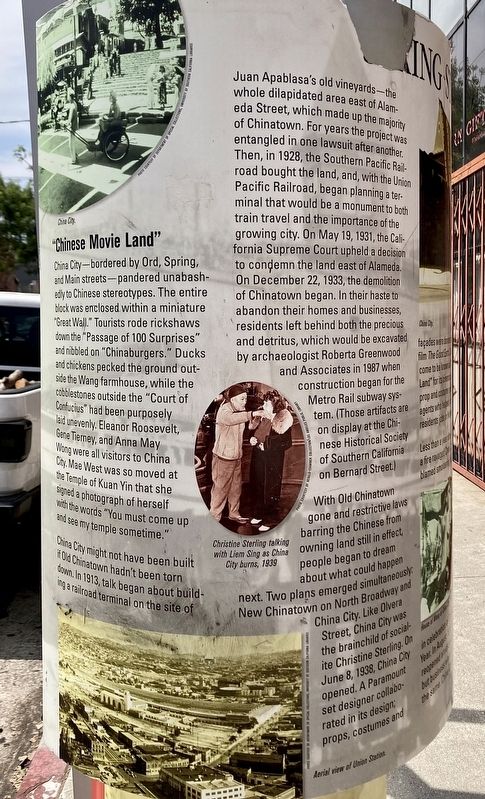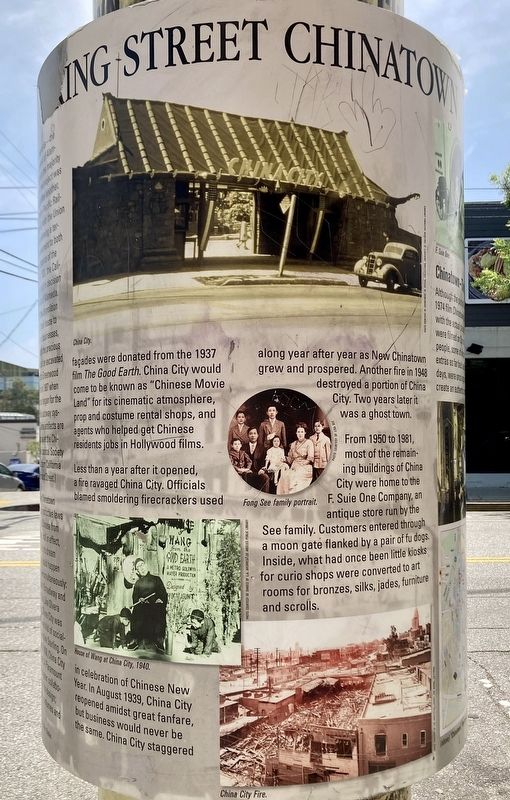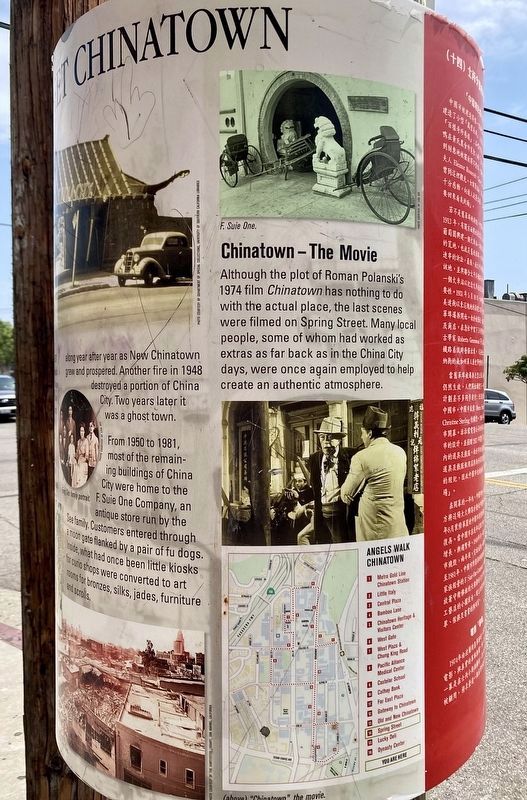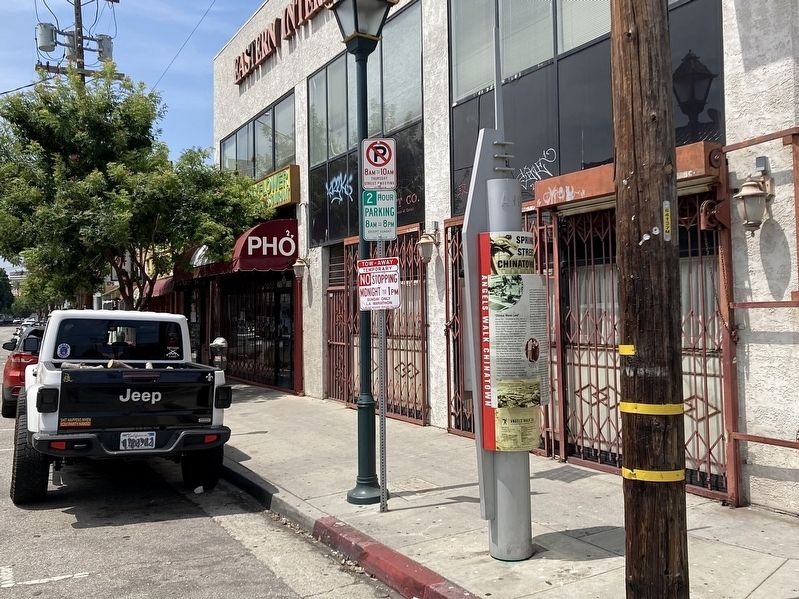Chinatown in Los Angeles in Los Angeles County, California — The American West (Pacific Coastal)
Spring Street Chinatown
"Chinese Movie Land"
China City — bordered by Ord, Spring, and Main streets — pandered unabashedly to Chinese stereotypes. The entire block was enclosed within a miniature "Great Wall." Tourists rode rickshaws down the "Passage of 100 Surprises" and nibbled on "Chinaburgers." Ducks and chickens pecked the ground outside the Wang farmhouse, while the cobblestones outside the "Court of Confucius" had been purposely laid unevenly. Eleanor Roosevelt, Gene Tiemey, and Anna May Wong were all visitors to China City. Mae West was so moved at the Temple of Kuan Yin that she signed a photograph of herself with the words "You must come up and see my temple some time."
China City might not have been built if Old Chinatown hadn't been torn down. In 1913, talk began about building a railroad terminal on the site of Juan Apablasa's old vineyards — the whole dilapidated area east of Alameda Street, which made up the majority of Chinatown. For years the project was entangled in one lawsuit after another. Then, in 1928, the Southern Pacific Railroad bought the land, and, with the Union Pacific Railroad, began planning a terminal that would be a monument to both train travel and the importance of the growing city. On May 19, 1931, the California Supreme Court upheld a decision to condemn the land east of Alameda. On December 22, 1933, the demolition of Chinatown began. In their haste to abandon their homes and businesses, residents left behind both the precious and detritus, which would be excavated by archaeologist Roberta Greenwood and Associates in 1987 when construction began for the Metro Rail subway system. (Those artifacts are on display at the Chinese Historical Society of Southern California on Bernard Street.)
With Old Chinatown gone and restrictive laws barring the Chinese from owning land still in effect, people began to dream about what could happen next. Two plans emerged simultaneously: New Chinatown on North Broadway and China City. Like Olvera Street, China City was the brainchild of socialite Christine Sterling. On June 8, 1938, China City opened. A Paramount set designer collaborated in its design; props, costumes and façades were donated from the 1937 film The Good Earth. China City would come to be known as "Chinese Movie Land" for its cinematic atmosphere, prop and costume rental shops, and agents who helped get Chinese residents jobs in Hollywood films.
Less than a year after it opened, a fire ravaged China City. Officials blamed smoldering firecrackers used in celebration of Chinese New Year. In August 1939, China City reopened amidst great fanfare, but business would never be the same. China City staggered along year after year as New Chinatown grew and prospered. Another fire in 1948 destroyed a portion of China City. Two years later it was a ghost town.
From 1950 to 1981, most of the remaining buildings of China City were home to the F. Suie One Company, an antique store run by the See family. Customers entered through a moon gate flanked by a pair of fu dogs. Inside, what had once been little kiosks for curio shops were converted to art rooms for bronzes, silks, jades, furniture, and scrolls.
Chinatown — The Movie
Although the plot of Roman Polanski's 1974 film Chinatown has nothing to do with the actual place, the last scenes were filmed on Spring Street. Many local people, some of whom had worked as extras as far back as in the China City days, were once again employed to help create an authentic atmosphere.
Erected 2003 by City of Los Angeles.
Topics. This historical marker is listed in these topic lists: Asian Americans • Entertainment • Industry & Commerce • Settlements & Settlers. A significant historical date for this entry is June 8, 1938.
Location. 34° 3.584′ N, 118° 14.284′ W. Marker is in Los Angeles, California, in Los Angeles County. It is in Chinatown. Marker is at the intersection of Spring Street and Ord Street, on the right when traveling south on Spring Street. Touch for map. Marker is at or near this postal address: 685 N Spring St, Los Angeles CA 90012, United States of America. Touch for directions.
Other nearby markers. At least 8 other markers are within walking distance of this marker. Lucky Deli (about 400 feet away, measured in a direct line); Historic Brick Pavers (about 500 feet away); Italian Hall (about 600 feet away); a different marker also named Italian Hall (about 600 feet away); Welcome to Chinatown (about 600 feet away); Far East Plaza (about 600 feet away); Sandstone Trough (about 600 feet away); Hammel Building (about 700 feet away). Touch for a list and map of all markers in Los Angeles.
Also see . . . Angels Walk L.A. Self-guided walking tours of historic neighborhoods in Los Angeles. The Spring Street Chinatown marker is part of the Chinatown walk. (Submitted on August 4, 2023.)
Credits. This page was last revised on August 4, 2023. It was originally submitted on August 3, 2023, by Craig Baker of Sylmar, California. This page has been viewed 93 times since then and 34 times this year. Photos: 1, 2, 3, 4. submitted on August 3, 2023, by Craig Baker of Sylmar, California.



